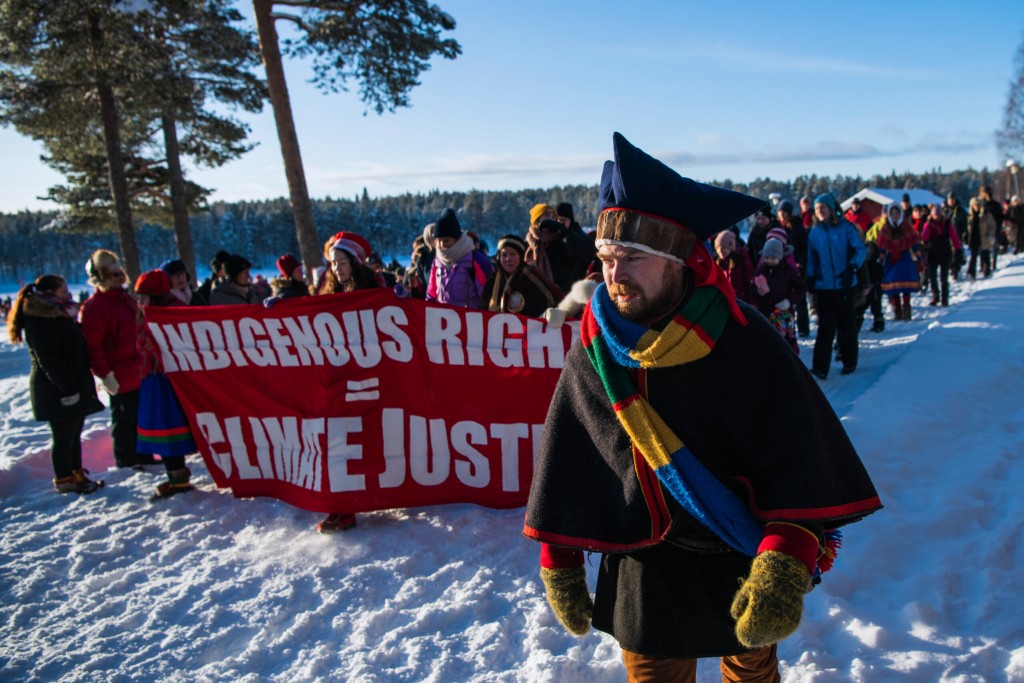CSUN Prof Part of International Effort Studying Indigenous History for Keys to Surviving Climate Change

History professor Natale Zappia, director of CSUN’s Institute for Sustainability, is part of an international effort studying Indigenous experiences to find clues for surviving climate change. Image of Sámi protestors above is courtesy of Natale Zappia.
Drought. Devastating fires and floods. Rising temperatures. Deadly heatwaves and cold spells. The extinction of an increasing number of plant and animal species. Climate change is threatening the world’s biodiversity and even human existence.
Lessons for surviving these dramatic changes can be found in the experiences of the world’s Indigenous people, according to California State University, Northridge history professor Natale Zappia, director of CSUN’s Institute for Sustainability.
Zappia is part of an international team of historical researchers who have received a $1.43 million grant from the Swedish Government Research Council to compare the experiences in Native North America and Nordic Sápmi. It is an effort understand how Indigenous societies survived when faced with devastating challenges caused by the twin forces of colonialism and environmental change.
“When one thinks of climate change and Indigenous experiences historically, what is discussed are disasters, folklore or situations that are victim-focused,” said Zappia, who teaches in the College of Social and Behavioral Sciences. “It’s time we started thinking about those experiences as solution-based, and as inspiration. Not only have these communities survived, but, in many instances, they have found opportunities to thrive. That’s why a lot of scientists are beginning to collaborate with these communities. They actually have answers that could be applied when thinking about how we, as a global community, deal with the impact of climate change, whether forest fire mitigation or thinking about aquaculture as a way of addressing global food insecurity.
“It’s the role of historians,” he said. “to remind us that we have to learn from the past and build on that knowledge in order to move forward as we look to the future.”
The project is hosted by Linnaeus University Centre for Concurrences in Colonial and Postcolonial Studies in Sweden. In addition to Zappia, the project’s researchers include Gunlög Fur, deputy vice chancellor for sustainability at Linnaeus University; Sámi artist Pirak Sikku; Sami Lakomäki, an associate professor of ethnohistory at Oulu University in Finland; history research fellow Janne Lahti with Helsinki University in Finland; and researcher Lindsay Doran with University of Eastern Finland.
The researchers will work closely with Indigenous communities in Scandinavia — in particular the Sámi community, the people native to the Nordic region of the globe, including Norway, Sweden, Finland and part of Russia — and Southern California, including members of the Chumash, Tataviam, and Kizh-Gabrieleño communities.
“Members of these communities will be true partners as we move forward with our research,” Zappia said. “They will be in the center of the dialogue. We hope to provide several opportunities for these communities to talk, both in person and online, so they, and we, can learn about their experiences and the lessons from those experiences that have helped their communities move forward.”
Zappia said the researchers hope these conversations will shed light on Indigenous survivance — a term coined by Anishinaabe novelist Gerald Vizenor to describe the active agency involved in survival — and inspire dialogue among policy makers on how to face the unthinkable consequences of global climate change and biodiversity loss.
The researchers will be examining the importance of cultural practices, arts and traditional knowledge as key reasons for Indigenous survivance.
Zappia said the information they learn will be important for “understanding and identifying human responses to climate change and loss so biodiversity.”
The project focuses on three themes — bordered spaces and remembered land, colonial education and traditional knowledge, and mapping native spaces and lifeways — which identify historical processes in North America and the Nordic region when subsistence and livelihood irrevocably changed for Indigenous communities.
The researchers will examine the impact borders imposed on the Indigenous peoples in the American West and in Sápmi from the 1850s to the early 1900s that severely affected land use and ecological conditions. They will also explore the efforts of colonial residential schools to fundamentally alter how Indigenous people understood, used and valued land.
One of the most pervasive ways of erasing Indigenous spaces occurred through mapping practices.
“Colonial maps replaced Indigenous placenames and hid complex histories of land use under blank spaces indicating uninhabited territory,” said Zappia, whose work will be focusing on mapping. This theme will compare three sites during different time periods to understand how competing cartographic cultures recorded, facilitated, resisted and engaged the environmental changes wrought by colonialism.
As part of this effort, Zappia will also be working with members of the Chumash, Tataviam, and Kizh-Gabrieleño communities to remap Indigenous traditional ecological knowledge in Los Angeles, one of the most densely urbanized regions of the United States.
“So much of this project will be exploratory, which is probably why historians don’t usually get grants of this size,” Zappia said, with a laugh. “We aren’t exactly sure what the outcome is going to be. But then, these communities, that have so much to teach us, really have never had an opportunity to talk about shared and unique experiences.”

 experience
experience